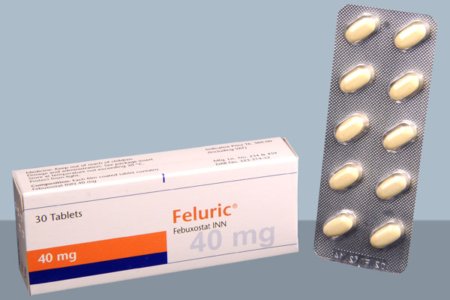
Type:10 Tablets
Generic Name:Febuxostat
Manufacturer:Healthcare Pharmaceuticals Ltd.
Price:৳120.00
Gout, Hyperuricemia
May be taken with or without food. May be taken w/o regard to antacid use.
Chronic Gout 40 mg/day PO initially; maintenance: 40-80 mg/day; increased if serum uric acid is >6 mg/mL after 2 weeks Hepatic impairment Mild to moderate (Child-Pugh class A or B): Dosage adjustment not necessary Severe (Child-Pugh class C): Data not available; use with caution
Safety and efficacy not established
Renal impairment Mild to moderate (CrCl 30-89 mL/min): Dosage adjustment not necessary Severe (CrCl <30 mL/min): Data not available; use with caution
Patients being treated with azathioprine, mercaptopurine, or theophylline.
Febuxostat selectively inhibits xanthine oxidase, the enzyme that catalyses the conversion of hypoxanthine to xanthine to uric acid, thereby decreasing serum concentrations of uric acid.
Cardiovascular death Patients with established cardiovascular (CV) disease treated with febuxostat had a higher rate of CV death compared with those treated with allopurinol in a CV outcomes study. Evaluate risks and benefits when prescribing febuxostat or continuing treatment. Gout Flare: An increase in gout flares is frequently observed during initiation of anti-hyperuricemic agents, including Febustat. If a gout flare occurs during treatment, Febustat need not be discontinued. Prophylactic therapy (i.e., non-steroidal anti-inflammatory drug (NSAID) or colchicine upon initiation of treatment) may be beneficial for up to six months. Lactation: Unknown whether drug is excreted into breast milk; use with caution
>1% Arthralgia,Elevated liver function test (LFT) results,Liver function abnormalities,Nausea,Rash
Pregnancy Limited available data in pregnant women are insufficient to inform a drug associated risk of adverse developmental outcomes Animal data No adverse developmental effects observed in embryo-fetal development studies with oral administration of febuxostat to pregnant rats and rabbits during organogenesis at doses that produced maternal exposures up to 40 and 51 times, respectively, the exposure at the maximum recommended human dose (MRHD) No adverse developmental effects observed in a pre- and postnatal development study with administration of febuxostat to pregnant rats from organogenesis through lactation at an exposure ~11 times the MRHD Lactation There are no data on presence of febuxostat in human milk, effects on breastfed infant, or on milk production; drug is present in rat milk Consider the developmental and health benefits of breastfeeding along with mother’s clinical need for therapy and any potential adverse effects on breastfed child from therapy or from underlying maternal condition
May increase plasma conc of mercaptopurine, azathioprine. Alteration of metabolism of xanthine oxidase substrate drugs (eg theophylline).